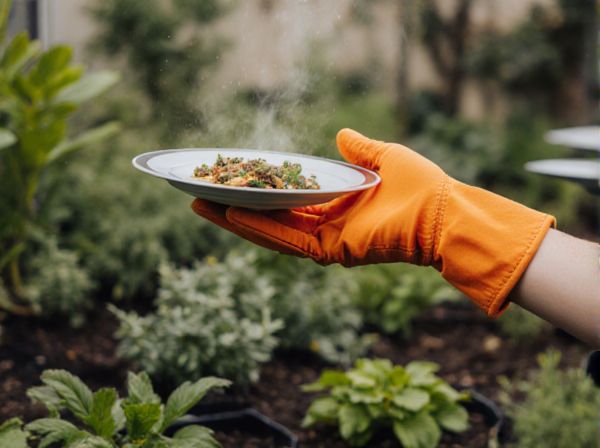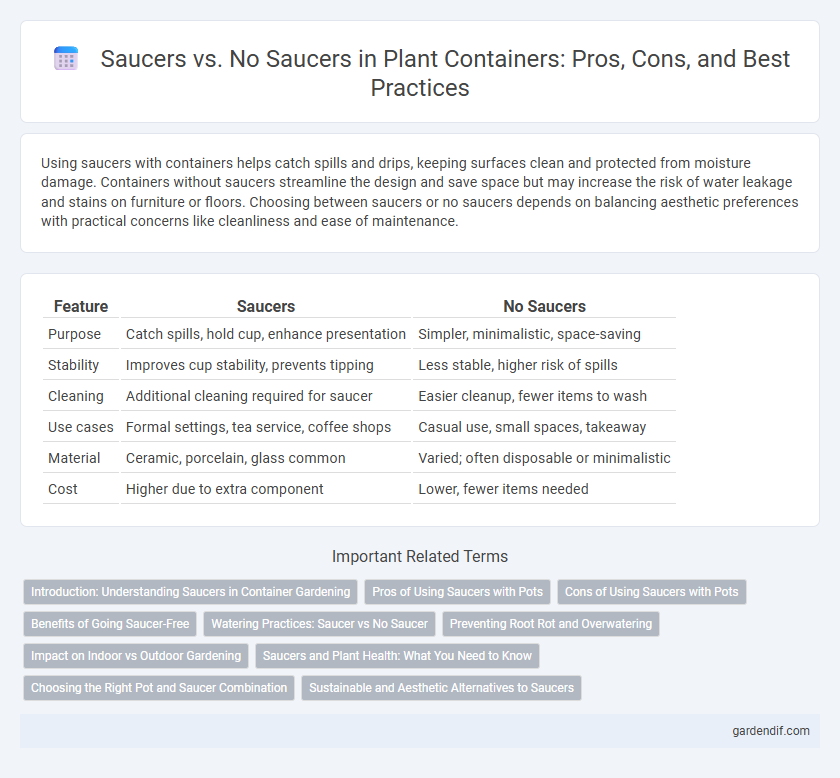
Saucers vs no saucers Illustration
Using saucers with containers helps catch spills and drips, keeping surfaces clean and protected from moisture damage. Containers without saucers streamline the design and save space but may increase the risk of water leakage and stains on furniture or floors. Choosing between saucers or no saucers depends on balancing aesthetic preferences with practical concerns like cleanliness and ease of maintenance.
Table of Comparison
| Feature | Saucers | No Saucers |
|---|---|---|
| Purpose | Catch spills, hold cup, enhance presentation | Simpler, minimalistic, space-saving |
| Stability | Improves cup stability, prevents tipping | Less stable, higher risk of spills |
| Cleaning | Additional cleaning required for saucer | Easier cleanup, fewer items to wash |
| Use cases | Formal settings, tea service, coffee shops | Casual use, small spaces, takeaway |
| Material | Ceramic, porcelain, glass common | Varied; often disposable or minimalistic |
| Cost | Higher due to extra component | Lower, fewer items needed |
Introduction: Understanding Saucers in Container Gardening
Saucers in container gardening are shallow dishes placed beneath pots to catch excess water, preventing soil runoff and protecting surfaces. They help maintain proper moisture levels by allowing water drainage while reducing the risk of root rot or overwatering. Choosing whether to use saucers depends on factors like plant type, container material, and location.
Pros of Using Saucers with Pots
Using saucers with pots effectively prevents water spillage, protecting surfaces from stains and moisture damage. Saucers also promote healthier plant growth by allowing excess water to drain while retaining some moisture for the roots. Moreover, they help maintain cleanliness and reduce the frequency of cleaning around indoor or outdoor container plants.
Cons of Using Saucers with Pots
Using saucers with pots can lead to water retention that promotes root rot and fungal growth, harming plant health. Excess moisture trapped beneath pots may cause soil to remain overly wet, suppressing aeration critical for root respiration. Furthermore, saucers can collect stagnant water, attracting pests such as mosquitoes and creating hygiene concerns indoors.
Benefits of Going Saucer-Free
Choosing containers without saucers reduces water accumulation, minimizing the risk of root rot and fungal growth. Saucer-free containers promote better airflow and drainage, ensuring healthier plant roots and preventing stagnant water issues. This approach also simplifies maintenance by eliminating the need to regularly empty excess water, leading to a cleaner and more hygienic planting environment.
Watering Practices: Saucer vs No Saucer
Using a saucer under containers helps retain excess water, preventing soil from drying out too quickly and reducing the frequency of watering. Containers without saucers allow better drainage, minimizing root rot risk but may require more frequent watering to maintain adequate moisture. Choosing between saucers and no saucers depends on plant type, drainage needs, and watering schedule.
Preventing Root Rot and Overwatering
Using saucers under containers helps prevent root rot by catching excess water and allowing plants to absorb moisture gradually, reducing the risk of overwatering. Containers without saucers may cause water to pool around roots, increasing the chances of fungal growth and root rot. Proper drainage combined with saucers ensures excess water does not stagnate, promoting healthier root systems.
Impact on Indoor vs Outdoor Gardening
Using saucers beneath containers in indoor gardening prevents water spillage onto floors, protecting surfaces from damage and maintaining cleanliness. In outdoor gardening, the absence of saucers allows excess water to drain freely, reducing the risk of root rot and promoting better soil aeration. Choosing between saucers or no saucers depends on balancing moisture control and drainage efficiency based on the specific gardening environment.
Saucers and Plant Health: What You Need to Know
Saucers play a crucial role in plant health by preventing waterlogging, which can cause root rot and fungal diseases. By catching excess water, saucers help maintain proper soil moisture levels, promoting healthy root development and reducing the risk of overwatering. Choosing the right saucer size ensures efficient drainage and prevents stagnant water accumulation, essential for optimal plant growth.
Choosing the Right Pot and Saucer Combination
Selecting the right pot and saucer combination ensures optimal drainage and plant health by preventing waterlogging and root rot. Saucers collect excess water, reducing mess and protecting surfaces, especially for indoor plants or delicate containers. Evaluate pot size, plant type, and drainage needs to determine if a saucer enhances functionality without compromising aesthetics.
Sustainable and Aesthetic Alternatives to Saucers
Sustainable alternatives to traditional saucers include biodegradable plant fiber trays and recycled plastic mats, which reduce waste and minimize environmental impact. Aesthetic options like resin-coated bamboo pads or cork coasters not only enhance container presentation but also offer durability and water resistance. Choosing these eco-friendly solutions supports sustainability goals while maintaining stylish functionality in container gardening.
Saucers vs no saucers Infographic

 gardendif.com
gardendif.com